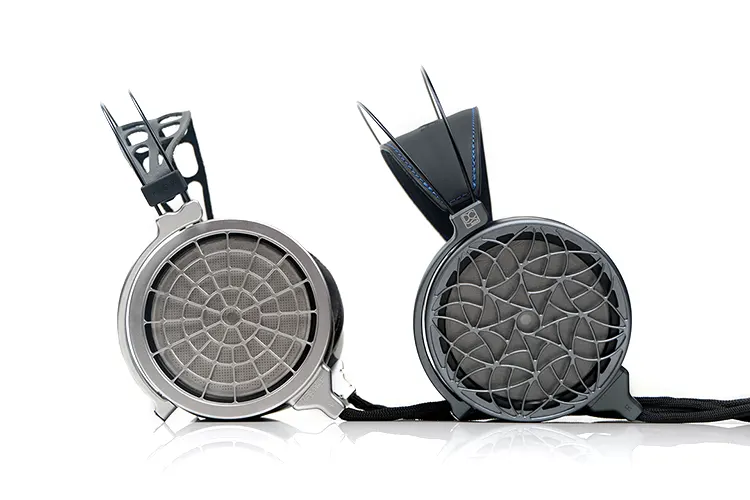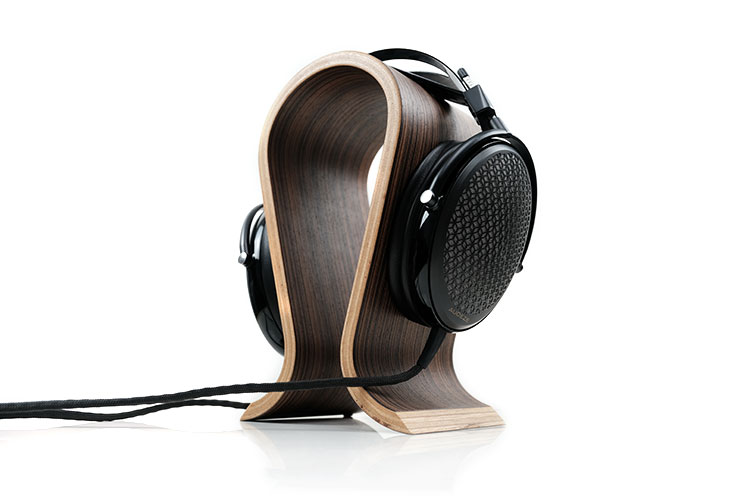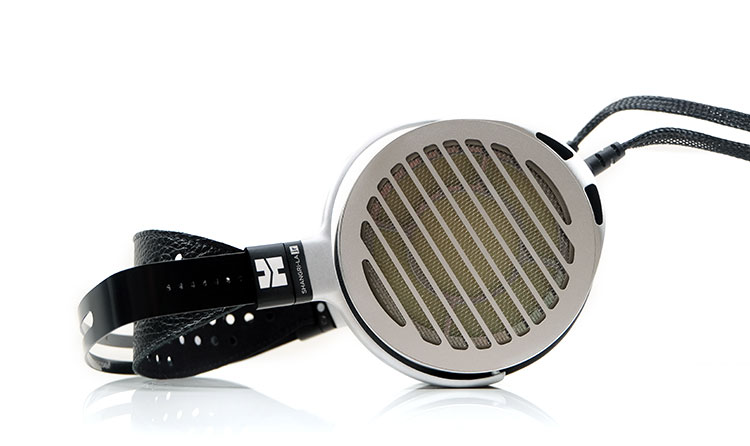Select Comparisons
The following comparisons were completed using a Stax SRM-007tII and HIFIMAN’s Shangri-La tube amplifier combined with a Musician Audio Aquarius and Ladder’s Schumann DAC.
Dan Clark Audio VOCE
$3299
The Dan Clark Audio VOCE was the company’s debut electrostatic headphone and its previous flagship offering. It was launched back in 2018 and won our Top Gear Award for best headphones that same year. You can read our full review of the VOCE here.
Technical
Both headphones use the same 88m electrostatic driver resistive coating and a 0.58mm spacing between it and the stator mesh to prevent excursion sticking so neither will rank as the most efficient e-stat headphones out there.
Whilst most decent electrostatic amplifiers will work, the dynamic headroom will improve substantially the more voltage swing your amplifier can deliver.
The key differences technical between the two drivers are the improved tensioning in the CORINA diaphragm to give it a more even and accurate performance over the VOCE.
And secondly, the introduction of the AMTS technology, migrated from the STEALTH and EXPANSE but with adaptations to suit the electrostatic driver and key tuning requirements. You will notice the AMTS ‘wedge’ right away when peering into the cups with that angled shape on the fabric at the base of the cup.
The AMTS technology in this instance was designed to combat any excessive treble energy and improve on the midrange coloration to give it a more natural tone without loss of detail or resolution.
Both are Pro Bias 580V headphones so they use the same cable with 5-pin terminations on their jacketed cables though it is rare these days to see modern normal 230V biased headphones in the market these days.

Design
Both the CORINA and the VOCE share similar design language cues. They are both round cupped designs, half-yoke support with lightweight Nitinol headbands and both share the same cable construction that can be disassembled if needed.
However, you can see right away where the recent DCA design approach has been applied to the CORINA with the introduction of the improved EXPANSE/Stealth pressure strap with an elastic adjuster that saves you from having to fine-tune the fit with your hands.
You also get an update on the aesthetics with the CORINA using a darker gunmetal finish to its aluminum alloy frame and a more flamboyant quasi-Fibonacci grill finish as well as deeper cups compared to the VOCE.
The pads have changed also and here is where you might find the most interesting observation. The VOCE is the lighter of the two headphones with the CORINA weighing 465g compared to 330g.
However, the better pressure strap dimensions combined with the wider surface suede-lined surface contact area of the CORINA works better for getting a secure fit and a better pressure balance.
The VOCE seems to have a marginally stronger level of vertical pressure and with less surface contact on the leather pads it can feel like it’s pulling down on the ears more.
Performance
The CORINA is like turning on a quality crossfeed filter whereas the VOCE sounds like you just turned it off. What that means is that the VOCE has a more prominent left-right stereo field whereas the CORINA sounds more integrated and focused sounding in its delivery.
You can pick that up quickly in layered vocal performances, lead or backing, where the VOCE casts them out wide but they feel like identikit singers on the left and right of the stage whereas the CORINA pulls them in tighter but either just behind or slightly to the side where they ideally should be.
To paint a mental picture of the imaging the VOCE builds more of a concave type of staging shape where its strongest at the widest points and leaner and less energetic in the center.
Not that the imaging of the lead vocal has vastly changed between both headphones when switching to the CORINA but rather it’s more convex in its shape giving more prominence progressively from the bass to the mids.
Now that might split e-stat fans so there is a preference thing here that comes through with both headphone’s timbral differences. For me, the VOCE has more treble presence so higher pitching notes will come through with more energy and sparkle. If you are after a traditional e-stat ethereal sound, the VOCE will be more familiar territory.
The CORINA sounds more like a properly mixed or live concert with a more natural sound. It sounds juicier through the bass and lower mids in particular and generates more power. It is the more rhythmic of the two in its presentation.
Definitely, the CORINA is a smoother, albeit darker and more rounded presentation but one that is more forgiving and meatier for a wider range of modern music genres.
Audeze CRBN
$4500
The Audeze CRBN is the company’s first electrostatic headphone and was launched in 2021. It was also a co-awardee for best headphones in our Top Gear Awards 2021. You can read our full review of the CRBN here.
Technical
Both headphones use fairly large Pro Bias compatible electrostatic drivers with the circular CORINA dust-sealed version measuring in at 88mm and the ovoid CRBN diaphragm at 90mm.
The CORINA driver uses a resistive coating for holding its charge, which is a fairly standard electrostatic driver technology.
The CRBN uses an ultra-thin diaphragm with carbon nanotubes directly suspended inside the material instead of a resistive coating inserted directly into the material to control and shape the required resistance level.
While not explicitly stated for the VOCE, DCA has been more focused with the CORINA on producing improved tensioning for a more even and accurate driver performance.
Whereas Audeze has relaxed the tension on the CRBN diaphragm via the carbon nanotubes to hold a better charge and a higher level of efficiency. It also means a bit more bass with that larger diaphragm excursion and like the CORINA increased space between the diaphragm and the stator to accommodate that.
To prevent the CRBN from being bass-heavy, Audeze has coated the rigid PCB manufactured stator’s conductive surface to retain a high dialectic strength with a perforation design to ensure that the top-end gets enough air and perceived articulation from the highs.
Design
Though they look very different, both the CORINA and the CRBN share the same house design legacy traits migrated over from each company’s existing planar magnetic headphone alternative.
Aesthetically, both are beautiful in their own way with striking grill designs and a high-quality finish in terms of engineering and parts finishing.
The key comfort difference is the reduced weight of the CRBN relative to their planar headphones such as the LCD-5 at just 470g whereas the CORINA actually went up a little from the VOCE to 465g and is technically heavier than the EXPANSE and STEALTH.
Some factors in the additional weight of the CORINA include the AMTS technology, the additional padded and wider pressure strap, and the deeper aluminum cups with more elaborate grills. The CRBN reduced weight comes primarily through their use of a polymer acetate material rather than aluminum for the cups.
On the head, the CORINA feels the better fit. The CRBN is quite a big headphone with those large ovoid cup designs and the classic Audeze carbon fiber headband and pressure strap.
You feel that size more on your head whereas the lower profile CORINA creates the impression of a smaller headphone on your head right away. The CRBN pad cavity openings are bigger but also longer. That always is my preference to best match my ear shape.
However, over prolonged use, I find the headband adjustment of the CRBN could do with 1-2 more notches since on the shortest length my ear still feels nug into the top of the pad’s inner cavity creating a stronger sense of vertical pressure compared to the CORINA.
Performance
Both are aiming for a very similar sound signature with a smooth-sounding timbre, vocals more to the fore, and some decent weight on the low end to go along with it. However, there are some differences though more subtle than our previous VOCE comparison.
The one area that did seem to hit me was the 2-5k range where the CRBN pushes the vocal just a little further forward around 2-3k but over a narrower band whereas the CORINA sounded more filled in both from a slightly higher bass elevation and from a 4-5k FR that retains more energy.
Now the CRBN has a stronger lower treble presence and you can hear that in percussion and higher pitching vocal timbre with a bit more bite to their performance.
However, two things for me here. The first is the way CRBN images the 4-5k percussion range behind the vocal so although they can sound a little cleaner they can lack a bit of comparative presence and solidity compared to the CORINA.
The second is fundamental from the CORINA on the lows. Both have a relatively similar level of bass quantity but I felt the dynamic impact of the CORINA lows to be marginally more substantial which in turn gave midrange instruments a slightly weightier tone.
Imaging-wise, the CRBN is more intimate on certain vocal pitches but at times I felt the CORINA image was a bit wider. A track I was testing from Tyler the Creator’s album, Igor called “I Think” has a lot of vinyl scratching noise effects around 1.30 minutes into the song.
Here, the CORINA felt a little more immediate and purposeful with the extreme ends of its stereo field whereas the CRBN kept the vocal a little taller and closer but the surrounding instruments narrower and politer sounding.
HIFIMAN Shangri-La Jr
$4000
The HIFIMAN Shangri-La Jr was launched in early 2018 and was intended to represent a slimmed-down version of their flagship Shangri-La electrostatic system.
We reviewed both the amplifier and headphones back in 2021 with the Headphones a co-awardee in our Top Gear Award of 2021. You can the full review of the Shangri-La Jr headphones here.
Technical
Both headphones are circumaural electrostatic headphones with the CORINA using an 88mm diaphragm. Though HIFIMAN does not state the precise size of the Shangri-La Jr driver, physically its driver seems to be slightly smaller. but not by much.
Both companies have tried to deliver super-thin diaphragms to maximize the push-pull response between their respective electrostatic headphone stator grids. The CORINA diaphragm thickness is 2.4 microns or 2.4uM whereas the Shangri-La Jr is thinner still at just 0.001m in diameter. For the record, the Sennheiser HE-1 diaphragm is also 2.4uM.
Both make a play on their stator grids with the Shangri-La Jr stators also being pitched as being ultra-thin at 0.050mm. DCA has not released their precise CORINA stator dimensions, but they also pitch them as ‘advanced’ and ultra-thin.
The big difference internally is the AMTS technology inside the CORINA and the Shangri-La Jr’s nano technology application. Both really are about exerting a level of control on the sound signature from each headphone but are done in very different ways.
With the Shangri-La Jr, the basic argument is that the lighter the diaphragm is, the faster it responds and the lower the potential for distortion. Hence that 0.001m diaphragm dimension. With the CORINA, DCA places more emphasis on the AMTS wedge to control wave diffusion, resonance, and standing back waves to get their ideal final sound signature from the driver.
Both are pro-bias terminated electrostatic headphones for they can work with a wide range of 580V pro-bias compatible energizers including Stax and Hifiman’s own hybrid Shangri-La Jr amplifier.
Design
The form factors are quite similar with rounded cups instead of elongated and though the CORINA weighs a bit more at 465g compared to the Shangri-La Jr’s 374g. The aesthetic or design flow is very much a legacy progression with both using signature features from their planar designs.
That includes the ultra-lightweight Nitinol and leather strap of the STEALTH and EXPANSE with the half gimbal arch on the CORINA and the classic arching headband, thinner leather strap and heavily articulating pivot block on the Shangri-La Jr.
In terms of engineering, the CORINA is the more complex looking of the two with that new and more intricate Fibonacci-type gunmetal finished front grill as opposed to the single molded silvery cup and grill window shade design on the Jr.
The Shangri-La Jr does feel lighter on the head compared to the CORINA but with similar pressure distribution. The CORINA has marginally more lateral clamping pressure but it’s only very slight.
Both headphones use hybrid pad designs though the quality of the CORINA leather and suede pads seem a little bit higher. They are also a little bit deeper with a wider surface contact area, however, the inner cavity of the Shangri-La Jr HarmonyPad pads seems marginally bigger, something I picked up a bit during usage.
One last note, the stock cable on the CORINA is a much better build than the lightweight and very thin Jr cable and can also be disassembled should you need to replace it.
Performance
The first thing to note is the greater efficiency of the Shangri-La Jr compared to the CORINA. The gap was not so huge when compared to the CRBN but the Shangri-La Jr did not tax my amps quite as much.
Performance-wise the Shangri-La Jr is all about height, treble presence, and perceived clarity with just a dash of low-end warmth to keep it closer to neutral than bright. The CORINA is more about warmth and density with stronger low-end fundamentals, weightier notes, and richer vocal presentations.
It leans darker compared to the Shangri-La Jr with less treble energy and perceived headroom. However, it also offers less treble dissonance over its upper-mid coloration so less prone to sibilance and percussion sharpness.
Brighter recordings are safer with the more rounded tonal quality from the CORINA whereas the Shangri-La Jr will seem more articulate and revealing but is also less forgiving.
Staging-wise the Shangri-La Jr will create an impression of a more open mid to high performance with closer vocal imaging but with less presence and impact on the lower-mids.
Your ear will be drawn more to a stronger 3-5k and 6-10k peak in the HIFIMAN tuning whereas the CORINA is more purposeful around 1-2k and definitely has a richer thicker presentation for guitar chord work. The CORINA gets my vote for classic and hard rock as well as modern R’n’B that needs that driving rhythm.
The HIFIMAN Shangri-La Jr is more of that traditional lightning-fast but ethereal e-stat sound with a hint of warmth to tame any shrillness in the highs. There will be fans of that and for me, I still would pick this for certain types of music that demand that airy performance.
Our Verdict
The Dan Clark Audio CORINA pretty much closes the ‘final loophole’ so to speak in terms of what the company is looking for in their signature sound for their high-end headphone lineup.
If you are coming over from the STEALTH or EXPANSE planar headphones then the CORINA feels like a natural fit with a sound signature not a million miles away either.
This is a very smooth tone and a surprisingly weighty sound signature for an electrostatic headphone. It could well be the perfect complement to any electrostatic collection already top-heavy with treble performers.
The resolution is there, and the detail is typically electrostatic in terms of articulation but this is a planted sound with more emphasis on the bass and mids rather than a heady sparkle or heavy treble overtones.
Just make sure you have a powerful enough energizer to go along with it. Some amps will struggle more than others to drive these optimally.
Once you do get the match right then this is a beautifully embracing sound, forgiving also, and very easy to listen to for hours. Which, coincidentally is exactly, what I ended up doing as soon as it was out of the box. Its versatility makes it ideal for a very wide range of modern genres.
Dan Clark Audio CORINA Specifications
- Driver Type: Electrostatic
- Driver Size: 88mm
- Capacitance with 2m Cable: 135pF
- Weight: 465gr
- Frequency Response: *Yes (flat to 6Hz)




